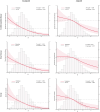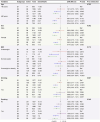Association Between the Serum Creatinine to Cystatin C Ratio and Cardiovascular Disease in Middle-Aged and Older Adults in China: A Nationwide Cohort Study
- PMID: 40281656
- PMCID: PMC12184220
- DOI: 10.1161/JAHA.124.040050
Association Between the Serum Creatinine to Cystatin C Ratio and Cardiovascular Disease in Middle-Aged and Older Adults in China: A Nationwide Cohort Study
Abstract
Background: The relationship between the serum creatinine to cystatin C ratio (sarcopenia index [SI]) and the risk of incident cardiovascular disease (CVD) remains unclear. Therefore, this study aims to explore the association between SI and the risk of incident CVD in middle-aged and older Chinese adults using nationally representative data.
Methods and results: We analyzed data from participants in CHARLS (China Health and Retirement Longitudinal Study) conducted in 2015 and 2018. The exposure variable was SI, calculated as the ratio of serum creatinine to cystatin C, multiplied by 100. The outcome variable was self-reported CVD (heart disease or stroke). A cross-sectional analysis was first performed using 2015 CHARLS data, which included 11 115 eligible participants (46.1% men; mean±SD age, 60.28±9.60 years). Logistic regression was used to estimate the association between SI and CVD. Longitudinal analysis was then conducted using the 2018 follow-up data, which included 8589 participants (46.4% men; mean±SD age, 59.57±9.42 years), with a median follow-up period of 3.0 years. Cox proportional hazard models were used to assess the relationship between SI and the risk of incident CVD, and a multivariate-adjusted restricted cubic spline model was used to explore the dose-response relationship. In the cross-sectional analysis, multivariate logistic regression revealed a significant negative association between SI and CVD. The longitudinal analysis identified 854 (9.94%) new CVD cases. Cox models showed that lower SI was significantly associated with an increased risk of incipient CVD. The multivariable adjusted hazard ratios for participants in the quartile 2 to quartile4 groups compared with those in the quartile 1 group were 0.94 (95% CI, 0.79-1.12), 0.63 (95% CI, 0.51-0.78), and 0.60 (95% CI, 0.47-0.75), respectively. Restricted cubic spline curves demonstrated a significant linear relationship between SI and CVD incidence (all P-nonlinear>0.05).
Conclusions: A lower SI was significantly associated with an increased risk of new-onset CVD in middle-aged and older Chinese adults. This suggests that SI has an important potential application as a serum marker of sarcopenia in predicting CVD.
Keywords: CHARLS; cardiovascular diseases; sarcopenia index.
Conflict of interest statement
None.
Figures



Similar articles
-
Association between serum creatinine/cystatin C ratio and symptomatic knee osteoarthritis incidents in Chinese middle-aged and older adults, considering sex variations: findings from the CHARLS.Clin Rheumatol. 2025 Jul;44(7):2993-3001. doi: 10.1007/s10067-025-07517-6. Epub 2025 Jun 3. Clin Rheumatol. 2025. PMID: 40461745
-
Association of intra-individual differences in estimated GFR by creatinine versus cystatin C with incident cardiovascular disease.Nutr Metab Cardiovasc Dis. 2025 Sep;35(9):104034. doi: 10.1016/j.numecd.2025.104034. Epub 2025 Apr 5. Nutr Metab Cardiovasc Dis. 2025. PMID: 40274428
-
Association of Differences in Cystatin C- and Creatinine-Based Estimated Glomerular Filtration Rate With Prevalence and Incidence of Stroke.J Am Heart Assoc. 2025 Jun 3;14(11):e039185. doi: 10.1161/JAHA.124.039185. Epub 2025 May 23. J Am Heart Assoc. 2025. PMID: 40407072 Free PMC article.
-
Smoking cessation for secondary prevention of cardiovascular disease.Cochrane Database Syst Rev. 2022 Aug 8;8(8):CD014936. doi: 10.1002/14651858.CD014936.pub2. Cochrane Database Syst Rev. 2022. PMID: 35938889 Free PMC article.
-
Effects of a gluten-reduced or gluten-free diet for the primary prevention of cardiovascular disease.Cochrane Database Syst Rev. 2022 Feb 24;2(2):CD013556. doi: 10.1002/14651858.CD013556.pub2. Cochrane Database Syst Rev. 2022. PMID: 35199850 Free PMC article.
Cited by
-
Association between different dimensions of the C-reactive protein-triglyceride-glucose index and future cardiovascular disease risk in individuals with cardiovascular-kidney-metabolic syndrome stages 0-3: a nationwide cohort study.Diabetol Metab Syndr. 2025 Jul 29;17(1):299. doi: 10.1186/s13098-025-01882-7. Diabetol Metab Syndr. 2025. PMID: 40731296 Free PMC article.
-
Association between fasting glucose/high-density lipoprotein cholesterol ratio and cardiovascular disease risk in Chinese middle-aged and older adults: a longitudinal study.Front Cardiovasc Med. 2025 Jul 14;12:1609891. doi: 10.3389/fcvm.2025.1609891. eCollection 2025. Front Cardiovasc Med. 2025. PMID: 40727574 Free PMC article.
References
-
- Martin SS, Aday AW, Almarzooq ZI, Anderson CAM, Arora P, Avery CL, Baker‐Smith CM, Barone Gibbs B, Beaton AZ, Boehme AK, et al. 2024 heart disease and stroke statistics: a report of US and global data from the American Heart Association. Circulation. 2024;149:e347–e913. doi: 10.1161/CIR.0000000000001209 - DOI - PMC - PubMed
-
- Roth GA, Mensah GA, Johnson CO, Addolorato G, Ammirati E, Baddour LM, Barengo NC, Beaton AZ, Benjamin EJ, Benziger CP, et al. Global burden of cardiovascular diseases and risk factors, 1990–2019: update from the GBD 2019 study. J Am Coll Cardiol. 2020;76:2982–3021. doi: 10.1016/j.jacc.2020.11.010 - DOI - PMC - PubMed
MeSH terms
Substances
LinkOut - more resources
Full Text Sources
Miscellaneous

